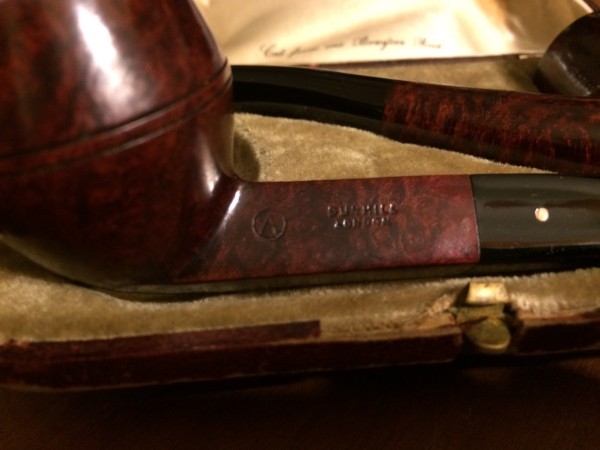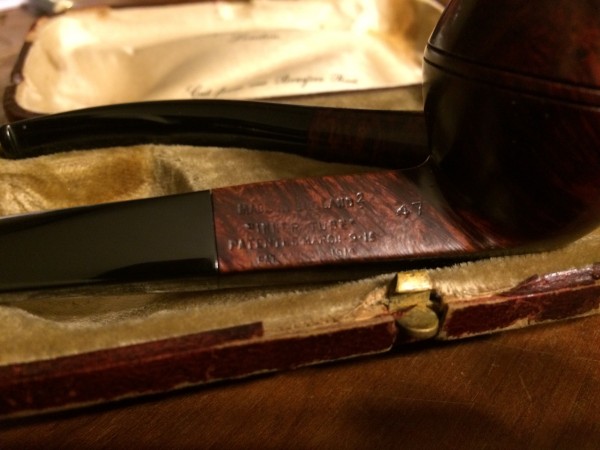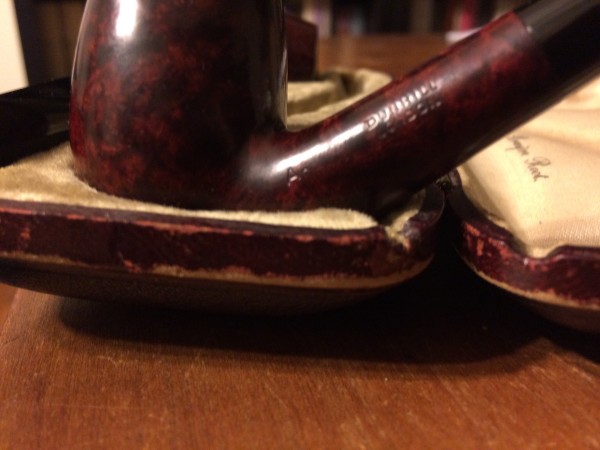Old Dunhill Date Question (calling the Duke Street Irregulars)
- Thread starter georged
- Start date
You are using an out of date browser. It may not display this or other websites correctly.
You should upgrade or use an alternative browser.
You should upgrade or use an alternative browser.
SmokingPipes.com Updates
Watch for Updates Twice a Week
- Status
- Not open for further replies.
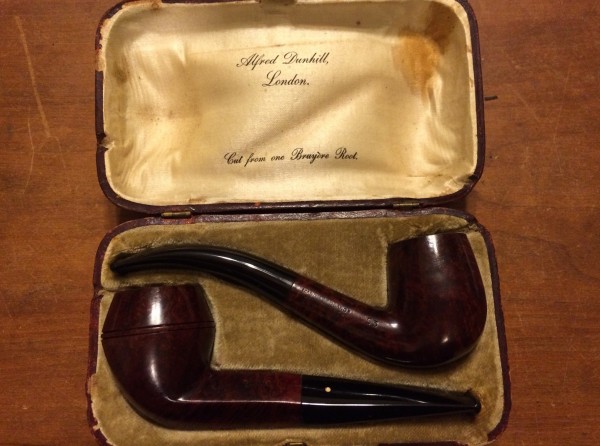
Here's the set. Sorry the photos aren't better. As you can see on the Dunhill shape 47, the carver got a little woozy carving the shank and shaping the stem to match it! Since the exact same shape could easily have garnered an uncircled A, an uncircled A with a stop, or even an HW had it been better executed, it seems to me that Loring is likely right to assume that the circled A represents the "base" Bruyere pipe, with the other marks being higher grades.
^^ What an exquisite set! That 53 has so much grace.... Welcome to the forums as well!............ : :
:
 :
:As you can see on the Dunhill shape 47, the carver got a little woozy carving the shank and shaping the stem to match it!

-
A fun notion, but probably not how it came to be.
I'm 99.9% sure what you have there is a "grafted" stem. One that was taken off a different pipe for some reason (a burnout, maybe, or the stem was simply found by itself in a desk drawer), and then fitted to your stummel as an improvised repair.
What's potentially romantic about it is virtually all the English pipes I've seen the graft trick performed on were made before WWII. Meaning the likely REASON they were done is because there was no other option at the time. Life was anything but normal during wartime, no one knew how long it would last, and people had far greater things to deal with than small pleasures like pipe smoking. A village's pipe repairman was off fighting in France, maybe, so the pipe's owner decided to fix it himself. And so on. The possibilities are endless. (But fun to think about from a collector's point of view)
With regard to the "A" nomenclature and stops et al, Mr. Loring had this (in part) to say:
"I have found no information as to the rationale for these seemingly random circles, stops and numbers, but since there is nothing else random about the Dunhill nomenclature I strongly suspect that these ancillary stamps in fact began as uptick work/quality/pricing codes. One might speculate that at least in the late 1910's and early 1920's with respect to Bruyeres that a circled "A" was the base grade with the uncircled "A" and an uncircled "A" followed by a round stop being the next two steps up. The fact, as noted earlier, that a short period in 1918 can be dated by the use of stops does not change that view. Those 1918 stops were added when there was no dating code (but see earlier footnote suggesting otherwise) and it may well be that the 1918 stops were intended to indicate a pricing change that effected the then newly manufactured pipes but did not apply to older stock. On the other hand from a perusal of 1920's catalogues and pipes in collections I also believe that while stops may represent additional work or quality they do not, at least after the early 1920's, necessarily indicate a higher selling price. For instance most Bruyeres after the early 1920's have a round stop after the uncircled "A" but appear to sell for the same price regardless of stops.
"The Dunhill factory stamp inventory log is of little assistance with respect to these small marks however, it does inventory two "A" stamps in 1938 one of which may have a small following period (as opposed to a round open stop). The 1940 log page also inventories two "A" stamps one plain and one with a clear slightly tilted square stop. These log entries suggest that stops after a brand side "A" were used into World War II and were used in conjunction with and as distinct from an "A" without a following stop."
"I have found no information as to the rationale for these seemingly random circles, stops and numbers, but since there is nothing else random about the Dunhill nomenclature I strongly suspect that these ancillary stamps in fact began as uptick work/quality/pricing codes. One might speculate that at least in the late 1910's and early 1920's with respect to Bruyeres that a circled "A" was the base grade with the uncircled "A" and an uncircled "A" followed by a round stop being the next two steps up. The fact, as noted earlier, that a short period in 1918 can be dated by the use of stops does not change that view. Those 1918 stops were added when there was no dating code (but see earlier footnote suggesting otherwise) and it may well be that the 1918 stops were intended to indicate a pricing change that effected the then newly manufactured pipes but did not apply to older stock. On the other hand from a perusal of 1920's catalogues and pipes in collections I also believe that while stops may represent additional work or quality they do not, at least after the early 1920's, necessarily indicate a higher selling price. For instance most Bruyeres after the early 1920's have a round stop after the uncircled "A" but appear to sell for the same price regardless of stops.
"The Dunhill factory stamp inventory log is of little assistance with respect to these small marks however, it does inventory two "A" stamps in 1938 one of which may have a small following period (as opposed to a round open stop). The 1940 log page also inventories two "A" stamps one plain and one with a clear slightly tilted square stop. These log entries suggest that stops after a brand side "A" were used into World War II and were used in conjunction with and as distinct from an "A" without a following stop."
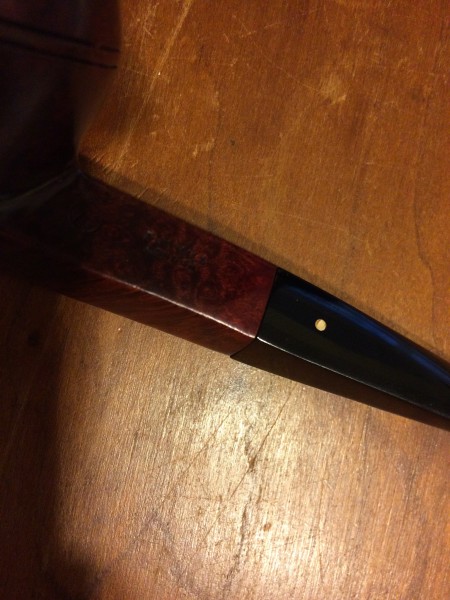
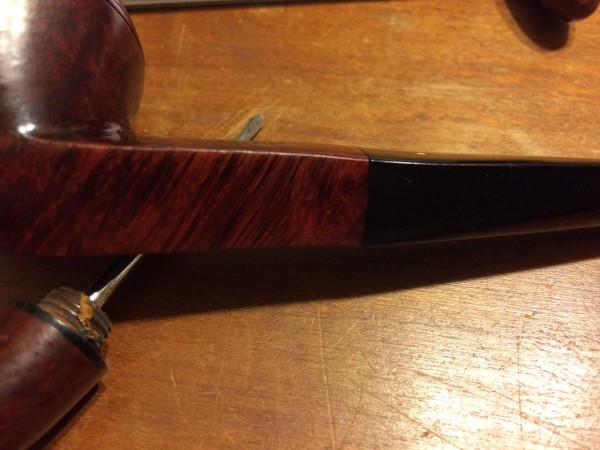
That makes perfect sense, George. Thanks for the correction on both counts. Although I can't quite capture it in the photo above, the pipe does appear to be sanded a bit right near the joint, and the lines have definitely been altered to meet the stem. (I mistakenly thought it was the other way around.)
The funny thing about it is that the line of the stem is also off - as you can see in the second photo - so maybe the original maker of the later stem was the woozy one, not the original carver, and the repairman had to do the best he could to fit it all together. (I'm sure you can relate to that, George....) The stem does bear a barely visible "REG. No 654638," which suggests a pre-WWII stem, although not necessarily a pre-WWII repair....
Thanks, too, for the long quotation, Hunter. That's the larger source of my quotation above.
As for the original question, I do think that the circled A denotes a lesser pipe than the A or the Ao, rather than the price of a particular shape number, as I have seen the same shape with different A stamps. Be that as it may, the circled A would still be relatively rare, as it was only used between 1918 and 1923 - or even 1920 and 1923 - whatever the quality of the pipe.
That's just the way I read Loring. I'm relatively new to the hobby, though, so I am eager to learn more.
- Status
- Not open for further replies.








